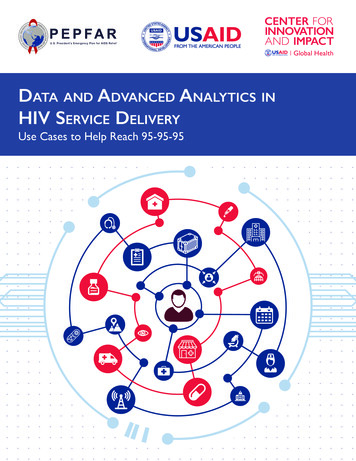
Transcription
Flipping the Odds of DigitalTransformation Success
Boston Consulting Group partners with leadersin business and society to tackle their mostimportant challenges and capture their greatestopportunities. BCG was the pioneer in businessstrategy when it was founded in 1963. Today, wehelp clients with total transformation—inspiringcomplex change, enabling organizations to grow,building competitive advantage, and drivingbottom-line impact.To succeed, organizations must blend digital andhuman capabilities. Our diverse, global teamsbring deep industry and functional expertiseand a range of perspectives to spark change.BCG delivers solutions through leading-edgemanagement consulting along with technologyand design, corporate and digital ventures—and business purpose. We work in a uniquelycollaborative model across the firm andthroughout all levels of the client organization,generating results that allow our clients to thrive.
Contents01 If Failure Is Not an Option, Why17 Factor 4: An Agile GovernanceIs Success So Rare?Mindset That Drives BroaderAdoption04 How Winners Win2111 Factor 1: An Integrated Strategywith Clear Transformation Goals13 Factor 2: Leadership Commitment from CEO Through Middle Factor 5: Effective Monitoring ofProgress Toward DefinedOutcomes23 Factor 6: Business-Led ModularTechnology and Data PlatformManagement27 A Bionic Roadmap15 Factor 3: Deploying High-CaliberTalent29 Setting Up for Success—andGoing Beyond
If Failure Is Not an Option, Why IsSuccess So Rare?With so much at stake to build digital capabilities that drive customer centricity and productivity, why do so many companies fail? Andnot just troubled companies—top performers, market leaders, andinvestor favorites, too. New BCG research shows that 70% of digitaltransformations fall short of their objectives, often with profoundconsequences.Digital transformations are an imperative as today’s leading corporations need to build bionic capabilities in orderto harness the potential of disruptive technologies andintegrate them into new processes, organization models,and ways of working. This necessity has been acceleratedby the pandemic.Our research shows that more than 80% of companiesplan to accelerate their companies’ digital transformations—and with good reason. Overwhelming evidenceshows that successful digital transformations drive performance and competitive advantage and propel companiestoward becoming bionic.Digital leaders achieve earnings growth that is 1.8 timeshigher than digital laggards—and more than double thegrowth in total enterprise value. In the short term, digitaltechnologies and ways of working offer productivity improvements and better customer experiences. In the medium term, digital opens up new growth opportunities andbusiness model innovation. Successful transformationsalso set companies up for sustained success; they won’thave to digitally transform again as they master continuous innovation. Investors say that 50% of companiesshould invest more aggressively in digital capabilities andtechnology.But there is a conundrum for management: digital transformations are difficult to execute. And with so much onthe line, only 30% of transformations succeed in achievingtheir objectives. There are good reasons for this, too. Deliv-1 ering such fundamental change at scale in large, complexorganizations is challenging, especially with short-termpressures. Individual leaders must decide whether theywant to jeopardize their careers against these odds or riskfalling behind.The technology is important, but the people dimension(organization, operating model, processes, and culture) isusually the determining factor. Organizational inertia fromdeeply rooted behaviors is a big impediment.Failure should not be an option, and yet it is the mostcommon result. The consequences in terms of investmentsof money, organizational effort, and elapsed time aremassive. Digital laggards fall behind in customer engagement, process efficiency, and innovation.In contrast, companies that are successful in masteringdigital technologies, establishing a digital mindset, andimplementing digital ways of working can reach a newrhythm of continuous improvement. Digital, paradoxically,is not a binary state, but one of ongoing innovation as newwaves of disruptive technologies are released to the market. Consider, for example, artificial intelligence, blockchain, the Internet of Things, spatial computing, and, intime, quantum computing. Unsuccessful companies willfind it extremely hard to leverage these advances, whiledigital organizations will be innovating faster and pullingfurther away from digital laggards—heading for that bionicfuture.FLIPPING THE ODDS OF DIGITAL TRANSFORMATION SUCCESS
Digital transformations can define careers as well ascompanies. The fundamental question on the minds ofall business leaders must be: “How can I ensure thatmy organization is among the 30% of successful transformers?”With the insights gathered from both our empirical workwith clients and a global survey of senior executives whosecompanies have undertaken transformations, we havecarefully analyzed the main drivers of success. The work isevidence based. It shows that getting just six things rightflips the odds for success from 30% to 80%.Here’s how the winners win.Flipping the Odds 30%Only 30% of organizationsachieve successful digitaltransformations 80% but the success rate is 80% among those that getsix factors rightBOSTON CONSULTING GROUP 2
The Six Critical Success Factors for Digital Transformations3 010203An integrated strategy withclear transformation goalsLeadership commitmentfrom CEO through middlemanagementDeploying high-calibertalent040506An agile governance mindsetthat drives broader adoptionEffective monitoring of progresstoward defined outcomesBusiness-led modulartechnology and dataplatformFLIPPING THE ODDS OF DIGITAL TRANSFORMATION SUCCESS
How WinnersWinOur research involves both internal and external datasets. The internal data comes from BCG’s ownexperience working with 70 leading companiesworldwide on their digital transformations over the pastseveral years. The external data comprises responsesoffered by 825 senior executives in a detailed survey abouttheir transformation experience.To determine how companies succeed, we asked executives to assess their transformations on a scale of 1 to 10.We defined success to include the percentage of predetermined targets met and value created, the percentage oftargets and value met on time, success relative to othertransformations, and success relative to management’saspirations for sustainable change.Only 30% of transformations met or exceeded their targetvalue and resulted in sustainable change; companies inthis group are in the win zone. Some 44% created somevalue but did not meet their targets and resulted in onlylimited long-term change; these companies are in theBOSTON CONSULTING GROUP 4
worry zone. And in the woe zone, 26% created limitedvalue (less than 50% of the target), producing no sustainable change. (See Exhibit 1.)From a comparative point of view, successful transformations created, on average, 66% more value, improved corporate capabilities by 82%, and met 120% more of theirtargets on time than those in the woe zone. Comparedwith the worrisome transformations, winners created 29%more value, improved capabilities by 20%, and met 32%more targets on time.What Drives SuccessDespite the differences in industries, starting points, andgoals, management teams wrestle with a very similargroup of questions at the start of a transformation: Why are we doing this? Do we need to become moreresponsive to rapidly shifting customer needs? Does ourproductivity need a step change improvement? Is ourability to innovate lagging? What should we do? The scope of digital transformations varies widely, from focusing on people (forexample, agile at scale) to overhauling technology andinfrastructure, replacing legacy IT platforms, and movingto the cloud. Many companies focus on specific businessoutcomes, such as personalization and digital marketing, end-to-end customer journeys, digital supply chains,and digital shared services. How do we implement the transformation? Thereare many questions around leadership, governance,resourcing, focus, approach (such as using pilots, incubators, or lighthouses), and sequencing. How do we makesure that product, channels, and support functions workin unison with the technology function, and how do weget middle management on board?Executives must make many important decisions beforestarting, and typically there are (legitimately) differingviews around the leadership table. These can range from“Let’s manage this in the business units so we can integrate well” to “We need to do something across the entireorganization to change the mindset”; or from “Let’s doExhibit 1 - Only 30% of Digital Transformations Are SuccessfulShare of transformations (%)Limited value created ( 50% of target);no sustainable changeValue created buttargets not met; limitedlong-term changeTarget value met orexceeded; sustainablechange ess score Source: BCG analysis.Note: Based on 895 transformations.The success score is calculated on the basis of the percentage of predetermined targets met and value created, the percentage of targets met andvalue created on time, the success relative to other transformations, and the success relative to management’s aspirations for sustainable change.15 FLIPPING THE ODDS OF DIGITAL TRANSFORMATION SUCCESS
some pilots, and if they succeed, we can expand to otherareas” to “We must commit the whole organization tochange.”When trying to bring everyone along with the overall plan, itcan be easy to compromise and lose focus on the transformational aspiration. This is where the trouble usually starts.But among all the decisions that must be made, six criticalsuccess factors stand out. The companies that get these sixfactors right flip their odds of success from 30% to 80%.The six essential success factors are: An Integrated Strategy with Clear TransformationGoals. The strategy describes the why, the what, andthe how, which are tied to specific, quantified businessoutcomes. Leadership Commitment from CEO through Middle Management. The company has high leadershipengagement and alignment, including often-overlookedmiddle-management ownership and accountability. Deploying High-Caliber Talent. Management identifies and frees up the most capable resources to drive thetransformation program. An Agile Governance Mindset That Drives BroaderAdoption. Leaders address roadblocks quickly, adapt tochanging contexts, and drive cross-functional, missionoriented, “fail-fast-learn” behavioral change into thewider organization. They deal with individual challengeswithout losing sight of the broader goals. Effective Monitoring of Progress Toward DefinedOutcomes. The company establishes clear metrics andtargets around processes and outcomes, with sufficientdata availability and quality. Business-Led Modular Technology and Data Platform. The company puts in place a fit-for-purpose, modern technology architecture driven by business needsto enable secure, scalable performance, rapid changedeployment, and seamless ecosystem integration.BOSTON CONSULTING GROUP When tackling these six factors, companies must satisfytwo conditions. First, management needs to make surethat each of the six is adequately addressed in their planning, preparation, and execution. Most companies in theworry and woe zones put effort into this. The problem isthat these organizations did not address each factor sufficiently.Sufficiency can often be a vague term and is susceptible toembellishment, especially when program leaders arejustifying their plans in order to get sign off and resources.In the sections that follow, we provide a readiness checklistfor each factor that companies can use to assess theirpositions. Imagine a high-jump contest. All the contestantshave been practicing, all have prepared for the competition. But only those who clear the bar will advance. Thedefining questions that we provide, based on empiricalevidence, will help companies determine whether theirchances of clearing the bar are low or high.Second, it is crucial to address all six factors. (See Exhibit2). Companies that adequately addressed only three orfour failed.We tested more than 35 factors that reflect commitment,strategy, approach, governance, financial and people resourcing, and technology enablers. (See the sidebar “BCG’sProprietary Research.”) Out of all of the possible combinations that we examined, none had the same impact onsuccess as these six. One reason is that many of them arecorrelated with one another. When organizations addressone factor effectively, they also tend to address one ormore of the others. For example, adopting an agile governance mindset correlates strongly with the adoption ofagile principles and culture through the organization.Similarly, the quality of talent correlates closely with turnover rates, so that when organizations bring in strongpeople to run the transformation, these individuals arealso less inclined to leave midway through the transformation.We examine each of the six factors in depth in the following sections.6
The technology is important, butthe people dimension is usuallythe determining factor.
Exhibit 2 - Companies Need to Perform Well on All Six Factorsto Be SuccessfulOn average, digital transformationshave three to four success factorsin place—a success rate of 30% 80% success rate withall six successfactors in placeLikelihood of success (%) 4100 11 4 23 18 2181605042301500194123456Number of key success factors in placeSource: BCG analysis.BOSTON CONSULTING GROUP 8
BCG’s Proprietary ResearchBCG’s leading position as a strategic partner in deliveringdigital transformations with our clients gives us a uniqueability to provide insights on transformation success. Weundertook a systematic and forensic analysis of 70BCG-supported digital transformations. We supplementedthis analysis with external research among 825 executiveswho have undertaken digital transformations in their companies. The combined data set covers all geographies,industry sectors, and types of digital transformation.We conducted a detailed survey asking all participantsabout the goals of their transformation, how successful ithas been, and the degree to which each of more than 359 potential influencing factors were in place. (See the exhibit.) These factors covered: Leadership commitment Strategy and approach taken Governance Financial and people resourcing Starting capabilities (such as technology and agile)FLIPPING THE ODDS OF DIGITAL TRANSFORMATION SUCCESS
We Tested More Than 35 Factors Across Five DimensionsStrategyand approachGovernanceFinancialand peopleresourcingCEO involvementComplete strategyand goals setEffective programsponsorSufficiencyof capexRobustness andflexibility of techand data platformsAlignment andinvolvement ofthe executivecommitteeCascading KPIs andaccountabilities withmeaningfulincentivesEffective programmanagerDynamicreadjustmentof capexSufficiency of ITinvestment andtimeAlignment andinvolvement ofmiddlemanagementAdoption ofagile principlesand cultureEffectiveness of thechief digital officerand chief technologyofficerSufficiency of opexAbility to supportand scale usecasesBoardinvolvementAdoptionof cloudC-suite digitalexpertise (excludingthe chief digital officer)Dynamicreadjustment ofopexData governanceand regulationsLevel ofambitionBenefits portfoliolinked to businessneedsCentral value-addinggoverning body (e.g.,PMO)Quality of talentData-drivencultureCommunicationto the market atthe startUse of externalecosystems andexpertsEffectiveproblem solvingSufficiency ofresourcesA proprietary, oradvantaged,data ivemonitoringTurnover ratesCommitmentLevel of pressureto transformEffective internalcommunicationTech enablers1For each transformation,survey respondentsdescribed the objectives andthe outcomes achieved 2Each respondent thenassessed its performanceacross the five dimensions 3We then determined the setof factors most important todrive successAgile mindset ingovernanceSource: BCG analysis.Note: PMO project management office.Based on a range of factors, including the percentage of the targets met, the amount of value achieved, and whether the targets were achieved on time.1Assessment offered either on a scale of 1 to 5 or by answering a yes-no question.2We then used the resulting data set to empirically analyzewhich combination of factors, if performed sufficiently well,had the biggest impact on success and which combinationdifferentiated successful transformations from those thatwere less successful. The six critical success factorsemerged from this analysis.We defined the success of a transformation on a scale of 1to 10 using a combined success score. This score wasbased on a set of survey responses that included the percentage of predetermined targets met and value achieved,the percentage of targets and value met on time, the success relative to other transformations, and the successrelative to management’s aspirations for sustainablechange.ing language. All input factors were included in the initialregression analysis, with the combined success score beingthe target or output variable. R2 and adjusted R2 values forthis initial regression analysis were measured, as well asthe coefficients and standard errors for each input factor.This analysis determined that this particular combinationand concentration of factors explained more of the variance of the data points than any other combination. Forexample, adding the sixth factor increased the likelihood ofsuccess significantly (by about 20%) while adding a seventhfactor had a negligible additional impact. Thus, we can sayconfidently that our combination of the six success factorsbest determines the success of a digital transformation.To determine the most effective combination of criticalsuccess factors, we used a multivariate analysis on the fulllist of potential influencing factors. We employed a multivariate linear regression approach, run using the “R” cod-BOSTON CONSULTING GROUP 10
Factor 1An Integrated Strategy withClear Transformation GoalsAll companies undertake some form of strategy setting. But only 40% overcome the hurdles to create atruly integrated strategy: a clear vision backed by aset of strategic imperatives and quantified business outcomes, linking digital to the overall business strategy andsustainable competitive advantage. A strong vision, orsense of purpose, energizes and aligns the organization.The strategy must be translated into specific actions embedded in an actionable business roadmap that addressesuse cases and technology, people, and organizationalcapabilities.One technology company had been spending money forseveral years on many discrete digital initiatives. But itmade little progress until the CEO decided to align theexecutive team around company-wide digital imperatives.The management team then designed an approach forimplementation that prioritized resources around impactand struck a workable balance between company-wideinitiatives and customized approaches at a business unitlevel.Exhibit 3 provides the defining questions to assess whetherthis factor is adequately addressed.11 FLIPPING THE ODDS OF DIGITAL TRANSFORMATION SUCCESS
Exhibit 3 - Readiness Check for an Integrated StrategyDEFINE THE OVERARCHINGVISION OR PURPOSEEMBED DIGITAL IN THEOVERALL BUSINESS STRATEGYALIGN LEADERSHIP ANDCREATE A CHANGE AGENDADo you have a clear aspiration that linksto competitive advantage and valuecreation?Is the success of the digitaltransformation critical to achieving youroverall business goals?Is the leadership aligned on what it willtake to effect the change required inbehaviors and skills across theorganization?DEVELOP A ROADMAP WITHPRIORITIZED INITIATIVESCONCENTRATE ON DISCRETEBUSINESS USE CASESDoes the business roadmap createtransparency around prioritizedactivities, deliverables, timelines,financial and people resources, and adynamic process to govern?Are you focused on a small number ofdiscrete and prioritized use cases withclear outcomes and committed,accountable business owners?ENSURE A CLEAR TECH ANDDATA STRATEGYHave the tech and data platformrequirements been determined on thebasis of the specifics of the strategy andbusiness needs?Source: BCG analysis.The starting point must be a clear vision, focused onand motivated by customers. To deliver, you need aspecific business case, led by senior executives, whoare committed to working together.– Andrew Thorburn, former Group CEO andManaging Director, National Australia BankBOSTON CONSULTING GROUP 12
Factor 2Leadership Commitmentfrom CEO Through MiddleManagementMost people understand the importance of commitment by the CEO and other top executives to largescale change. Yet, by itself, commitment is notsufficient. Companies must also involve the relevant middle managers in the planning and execution of the transformation program to make sure they buy into the goalsand strategy. Without this, middle managers often becomesources of resistance, defending functional siloes andpower bases. As one executive put it, “We knew that it wasabsolutely critical to address the ‘frozen middle.’ Wecouldn’t afford our middle management to be cynical or towant to preserve the status quo.”Companies also need to recognize the threats to people’scareers that transformations can represent. Automation,bionic processes, and new ways of working mean job losses, especially if retraining and upskilling programs can’tcompensate. And new digital skills must be brought in.Middle managers feel particularly vulnerable. As organizations adopt agile operating models, they must adjust compensation programs and career paths and then communi-13 FLIPPING THE ODDS OF DIGITAL TRANSFORMATION SUCCESS
Exhibit 4 - Readiness Check for Leadership CommitmentSHOW THE VISIBLE COMMITMENT OF LEADERSHIPFROM THE CEO TO RELEVANT SPONSORS ANDEXECUTIVESDo the CEO and key executives have a high-profile role incommunicating the importance of the transformation?DEVELOP A MOTIVATED AND EMPOWERED MIDDLEMANAGEMENTHave key middle managers been involved in developing theobjectives, business cases, and transformation approach?Are middle managers conveying the most importantcommunication messages to their teams?Are executives consistently supporting the transformationleadership to address and resolve issues?Is the senior leadership participating in frequent, forensic reviewsof progress?Are mentoring and feedback provided to middle managers toempower them to lead change?Is there an active plan to reward champions and sidelineblockers?Are middle managers’ performance objectives linked to thetransformation success?Source: BCG analysis.cate those changes effectively. A motivating purpose,coupled with transparency, is a powerful weapon for bringing people on board and activating behavioral change.One successful company took the time to involve middlemanagement in the design of the transformation, makingit evident that individual managers would be unable todeliver their specific targets unless company-wide digitization succeeded. In another example involving a global organization, management took care to demonstrate the impact of the digital solutions in one operating companybefore scaling to its functions in other countries. Seniorexecutives also worked hard to respect different countries’business contexts while remaining firm about the need forfull adoption.In our survey, three out of four executives felt that they hadgood leadership engagement. In fact, however, only one inthree had committed middle-management engagement. Inthose companies, the middle managers felt motivated andempowered to deliver outcomes.To assess your organization’s leadership commitment fromthe CEO through middle management, see the questionsin Exhibit 4.It was the persistence and results-oriented mindsetfrom the leaders as well as employees from all partsof the company that got us through.– Somkiat Lertritpuwadol, Senior ExecutiveVice President, Corporate Strategy, IRPCBOSTON CONSULTING GROUP 14
Factor 3Deploying High-Caliber TalentCompanies often do not have the mix of skills thatthey need, and they tend to underestimate the skillsand expertise of the people required to execute asuccessful digital transformation. In fact, only one in fourorganizations in our research cleared the hurdle on thisdimension. The successful companies paid particularattention to transformation leadership positions, addressing both digital expertise and broader skills. One executivetold us, “You need a core of around 10 digital superstars todrive new ways of working in around 100 others.” Just asimportant are broad-based skills, such as persistence,pragmatism, resilience, collaboration, critical thinking,creativity, emotional intelligence, and learning agility.Successful companies demonstrated visible commitmentto the organization by appointing the best people with thehighest potential to lead the transformation. They carefullyassessed the roles and skills required and were prepared tosource some roles externally if needed. They also ensured15 FLIPPING THE ODDS OF DIGITAL TRANSFORMATION SUCCESS
Exhibit 5 - Readiness Check for High-Caliber TalentSHOW VISIBLE COMMITMENT THROUGHRESOURCING DECISIONSTAKE AN OPEN-SOURCE APPROACH TO GETTINGTHE RIGHT TALENTHave you sent a clear signal to the organization that the bestperformers will be involved and that this is a careeradvancing program?Do you have a detailed assessment of the skills required andthe gaps to be filled?Have you taken extra care around who fills pivotal roles, suchas that of the program manager?Do you have a plan to source and retain required skills in atimely manner, including hiring new talent or accessingexternal resources?MANAGE THE TALENT DYNAMICALLY TOSUSTAIN AND REFRESHENSURE EFFECTIVE TEAM COMPOSITIONAre there enough digitally literate people to drive newthinking?Have you sourced team members tactically from businessunits and functions so that they become champions in criticalareas?Are processes in place to evaluate and develop teammembers and replace poor performers?Do you have visible ways to celebrate successes and managemorale?Source: BCG analysis.that talent was managed actively—by, for example, rewarding and retaining strong performers and rotating out underperformers.To assess whether your organization is playing its part insecuring high-caliber talent to drive transformation, seeExhibit 5.A large airline understood that the selection of the transformation program manager was key to success. It took thetime to find a digital native who also had the leadershipskills to be authentic, honest, persistent, and, when necessary, confronting.You need program leaders who bring digital skills anda digital mindset as well as the ability to navigateorganizational dynamics. Qualities like stamina,authenticity, and a single-minded focus on the goalsare also critical.– Sander Stomph, Vice President LeadingDigital Operations, KLMBOSTON CONSULTING GROUP 16
Factor 4An Agile Governance MindsetThat Drives Broader AdoptionThis success factor has two elements that turn out tobe highly correlated. First, the leadership must govern the transformation with an agile mindset. Thismeans engaging deeply enough to be able to actively steerdecisions, tradeoffs, and priorities by serving as an effectiveescalation point for teams. One executive described hercompany’s approach this way: “We had a weekly ‘impediments’ agenda item where program leaders could tellexecutives about roadblocks and get them addressed.”Leaders should also be prepared to adapt the governanceand adjust priorities on the basis of changing context. Inthis way, they demonstrate resilience and reinforce commitment to the vision and goals, especially when there aresetbacks or moments of truth, such as funding or competitor pressures.Second, the leaders must drive agile behaviors broadly intothe organization. This requires authentic belief in thebehavioral changes required, as well as playbooks, processes, and support to enable the organization to work in across-functional, mission-oriented way.17 FLIPPING THE ODDS OF DIGITAL TRANSFORMATION SUCCESS
Exhibit 6 - Readiness Check for an Agile Governance MindsetDEMONSTRATING RESOLVEAND PERSEVERANCEPRAGMATIC SUPPORT TORESOLVE ROADBLOCKSCOMMITMENT TO PIVOT BASEDON CONTEXT AND LEARNINGWhen setbacks occur, is the leadershipcommitted to regrouping and pushingahead?Is the leadership available to listen toconcerns and challenges from theteams?Does the organization perceiveleadership as authentic in itscommitment to succeed?Is the leadership ready to take actionsto resolve escalated and contentiousissues?Is the leadership team ready to adapt toimprove—through, for example, newgovernance, more delegation, andreprioritizing resources and deliverablesfor better outcomes based on newinformation?BEHAVIOR CHANGE ACROSSTHE ORGANIZATIONIs there visible commitment at the topto new ways of working, as evidenced byfunding, setting up cross-functionalmissions, and tolerance of some of theambiguities of an agile approach?Are you investing in skills, processes,ceremonies, and positions, such as agilecoaches, to scale up agile behaviors?ENSURING THAT TEAMSEMBED EFFECTIVE AGILEPRINCIPLESAre silos being broken down, and areteams working in cross-functional ways?Are teams demonstrating an agilemindset through sprints, rapidescalation, building minimum viableproducts, and a "fail-fast-learn"approach?Source: BCG analysis.Our vision was to build a connected company,internally and externally, with customers andsuppliers. We knew it would take three to five yearsand spent considerable time building the conviction tostay on this course.– Phil
1The success score is calculated on the basis of the percentage of predetermined targets met and value created, the percentage of targets met and value created on time, the success relative to other transformations, and the success relative to management’s aspirations for sustainable change. 70 26 4










